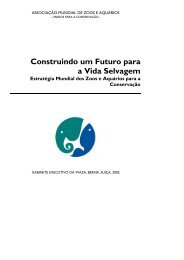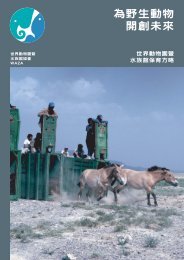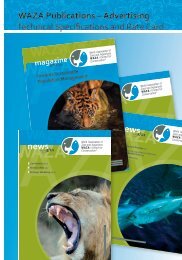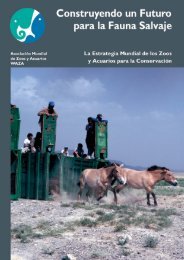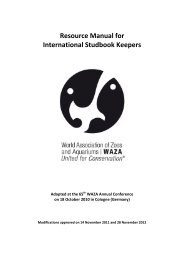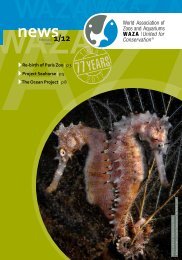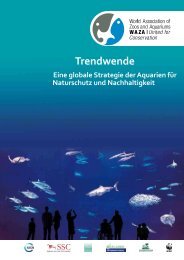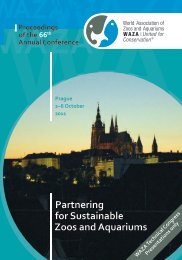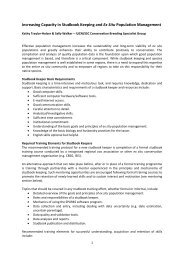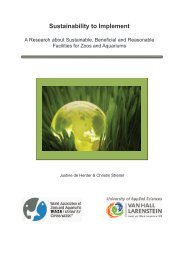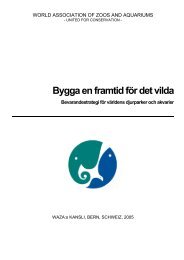Towards Sustainable Population Management - Waza
Towards Sustainable Population Management - Waza
Towards Sustainable Population Management - Waza
Create successful ePaper yourself
Turn your PDF publications into a flip-book with our unique Google optimized e-Paper software.
WAZA magazine Vol 12/2011<br />
In 2008, the Australasian Species<br />
<strong>Management</strong> Program (ASMP),<br />
the species management arm of<br />
ZAA, commissioned a review of the<br />
delivery of species management outcomes<br />
within the Australasian region.<br />
The initial discussion related largely<br />
to exotic taxa and was prefaced by<br />
a report prepared on the status of all<br />
exotic taxa under formal management<br />
within the Australasian region.<br />
The report suggested that an alarming<br />
proportion of exotic taxa were<br />
unlikely to be sustainable in the long<br />
term, including some which were<br />
facing imminent local extinctions in<br />
Australasian zoos (Barlow & Hibbard<br />
2005). The scope of this discussion<br />
quickly expanded to include all Australasian<br />
programmes (both native<br />
and exotic) where a level of formal<br />
management had been applied.<br />
The ASMP Committee, through the<br />
ZAA Board of Directors, launched<br />
a full review of species management<br />
services under the banner of the<br />
Future Directions Project. The ASMP<br />
Committee recognised the sound<br />
foundations already in place and focused<br />
on addressing issues that had<br />
arisen as a result of the programme<br />
maturing and operating environments<br />
evolving. In broad terms, the<br />
project was to examine resourcing,<br />
policies, processes and species to be<br />
managed. In order to apply specific<br />
and measured resolutions, the<br />
project was tasked with determining<br />
the specific causes for the shortfall in<br />
overall population “health” of species<br />
in managed programmes and establishing<br />
actions to resolve these.<br />
The aim of the project was to improve<br />
the effectiveness of species management<br />
programmes through accountability,<br />
disciplined processes and<br />
inclusiveness, in order for the ASMP<br />
to remain current and relevant as<br />
a member service to the ZAA membership.<br />
Methodology<br />
The ASMP Future Directions Project<br />
commenced in 2008 and was earmarked<br />
for completion in 2010. There<br />
were various components to the project<br />
beginning with a rigorous review<br />
of the species selected for management<br />
and the level to which they could<br />
or should be managed. This article will<br />
not attempt to document the species<br />
review process, other than to recognise<br />
that many excellent models have<br />
been developed and that the Australasian<br />
model was not radically different<br />
from others in current use; that is, it<br />
addresses key goals identified in the<br />
World Zoo and Aquarium Conservation<br />
Strategy (WAZA 2005). For exotic<br />
taxa, the Australasian model rated<br />
highly the ongoing ability to acquire<br />
the species both in terms of import<br />
legislation and access to new genetic<br />
material (either by inter-regional or<br />
range state sources). This was of specific<br />
importance given the small size<br />
of our regional populations and the<br />
need to rely on periodic importation to<br />
sustain most populations.<br />
The next step in the process was the<br />
development of a benchmarking<br />
tool with the current working title of<br />
the ASMP Health Check Report. The<br />
Health Check Report is by no means<br />
a completed piece of work and continues<br />
to evolve to reflect a changing<br />
zoo environment and respond to<br />
any issues that might be identified in<br />
the future. In the past, ZAA has used<br />
a compliance report to measure institutional<br />
adherence to specific recommendations<br />
on specimen transfers<br />
and breeding based on studbook<br />
analysis. The development of the<br />
Health Check Report has expanded<br />
the scope substantially and shifts the<br />
focus of assessment onto the delivery<br />
of a suite of measurable programme<br />
goals rather than the performance of<br />
individual contributors. The Health<br />
Check Report measures the overall<br />
health of the programme as well as<br />
giving insight into the “health” of<br />
specific areas.<br />
ZAA Sustainability<br />
It was acknowledged that in many<br />
cases sound scientific principles of<br />
small population biology had been<br />
applied; however, the results in<br />
programme performance were not<br />
all meeting expectations. A number<br />
of claims were put forward, many<br />
of which were consistent with those<br />
identified by Lees & Wilcken (2009),<br />
and included:<br />
• A lack of spaces being offered for<br />
managed species, fuelled by a trend<br />
away from multiple, small, speciesspecific<br />
facilities to larger multi-taxa<br />
“experiences”, including a move<br />
away from extensive off-display<br />
holding facilities.<br />
• Government legislation over the<br />
import of exotic taxa was having<br />
a negative impact on founder recruitment<br />
for populations.<br />
• Species biology in some instances<br />
was not necessarily aligned with the<br />
mean kinship and genetic management<br />
employed.<br />
• The concept that genetic management<br />
was better understood and<br />
more rigorously applied by species<br />
coordinators than demographic<br />
management and in some instances<br />
contributed to demographic instability.<br />
• Species management expertise and<br />
innovation required further development.<br />
• Implementation of specific programme<br />
recommendations although<br />
usually attempted often was<br />
not necessarily achieved, or resulted<br />
in the desired outcome.<br />
The Health Check Report was developed<br />
to measure fact-based criteria,<br />
by breaking down species management<br />
practices into measurable components.<br />
This enables a programme’s<br />
performance to be quickly assessed<br />
and any remedial measures applied in<br />
a timely manner where programmes<br />
are seen to be falling short of expectation.<br />
In addition, it allows for the acknowledgement<br />
of positive progress<br />
and feedback to the many species<br />
coordinators hosted by member zoos.<br />
7<br />
»



